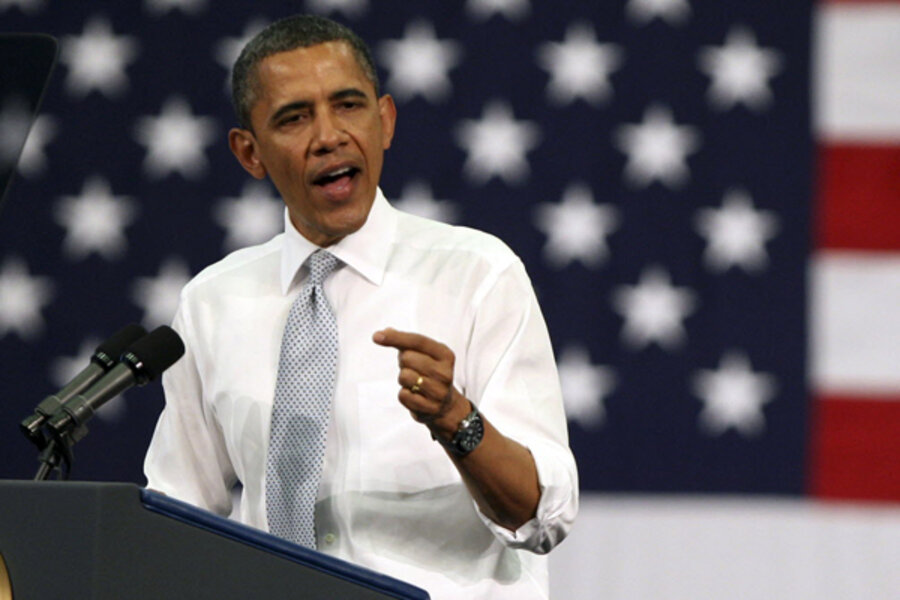Obama and Romney scrap along battleground Florida's I-4
Loading...
| ORLANDO, Fla.
In the presidential battleground with the biggest prize, Democrat Barack Obama is focused on ratcheting up voter turnout in Florida's university towns, its Hispanic enclaves around Orlando and its Jewish communities in the south. Republican challenger Mitt Romney is working to squeeze as many votes as possible out of north Florida's conservative military bastions, the senior-heavy Gulf Coast and Miami's Cuban community.
But their strategies to energize core supporters overlap in the central Florida swing-voting region that's key to winning the state and its 29 electoral votes. Voters along Interstate 4, which stretches from Tampa Bay to Daytona Beach, will determine the outcome if the race remains close into the fall, as expected. About 45 percent of the state's voters live in that 17-county area.
"Neither party has enough base alone, which is why those persuadable places, particularly along the I-4corridor, are so important," said Steve Schale, a Democrat who ran Obama's Florida campaign four years ago.
It seems that's usually the case, judging by Florida's track record of hard-fought races and narrow presidential outcomes since the 2000 race landed at the Supreme Court, which then handed the White House to Republican George W. Bush.
Bush won the state again four years later, 52 percent to 47 percent, over Democrat John Kerry. But in 2008, the state sided with Democrats when Obama defeated Republican John McCain, 51 percent to 48 percent.
This year, the stakes are hard to overstate: Obama's re-election is nearly assured should he repeat his 2008 victory in Florida, based on how the states lean now. His standing in Florida is far more precarious than it is in other contested states — so if he wins Florida, it's likely that he's won in many other states as he looks to cobble together the 270 Electoral College votes it takes to win. Romney's state-by-state routes to reaching the magic number are more limited than the president's, and a Florida victory would make it far more probable that he could win the presidency.
The electorate in Florida is virtually unchanged from 2008 because the ailing economy stifled the population growth of the previous decade. And in this campaign, the economy dominates.
The recession took a deep toll on the state's recreation industry, especially around Orlando. A decline in foreign trade hurt the Port of Tampa, Florida's largest shipping port. The housing crisis fueled widespread home foreclosures and severely hampered the construction industry on which much of the region's immigrant-heavy workforce relies.
Florida's unemployment rate was 8.6 percent in May, slightly higher than the national average and all other presidential battleground states except Nevada.
A little more than four months before the Nov. 6 election, Obama narrowly leads Romney in statewide polls.
The president and his Democratic allies spent roughly $17 million in television advertising in Florida from April, when Romney effectively became the GOP presidential nominee, through last week. Romney's campaign hasn't been on the air in the state since then, but his allies have doled out $12 million during that time. The ads are heavily concentrated on the Tampa and Orlando media markets, which are cheaper than Miami's and reach far more swing voters.
Of the $2.8 million spent on TV ads in the state last week, $1.8 million was in this region.
Obama is on defense in the I-4 corridor, which he won by a very slim majority in 2008 after Bush won it in 2000 and 2004. Republicans hope that holding their national convention in Tampa in August will give them an edge.
In a close race where anything could be determinative, organization could count hugely and, on this point for now at least, Obama has an advantage. He never dismantled his 2008 campaign infrastructure in the state and has 36 campaign offices. Romney has quickly opened 23, run jointly with the Republican National Committee.
"In a race like this, that is so close and so hard-fought, door-to-door, mail and telephones could make the difference," said Republican Sally Bradshaw, a top Florida aide to Romney during his failed 2008 presidential bid.
Of paramount importance for both candidates right now: energizing and mobilizing core supporters.
For Obama, that means working to tap the burgeoning Puerto Rican community — an outlier in Florida's sluggish population growth — around Orlando. Puerto Ricans tend to support Democrats.
Romney's campaign, in turn, sees a chance to shave Obama's advantage among Jewish voters, for whom support for Israel is a top issue. Aides say Romney has tapped into some Jews' irritation over the president's seemingly sympathetic statements toward the Palestinians. Aides said Monday that Romney also planned to visit Israel this summer.
But both candidates stressed central Florida early on.
Obama was in Tampa in April, announcing a measure to promote trade with Latin America. Romney was in neighboring St. Petersburg in May, promoting plans to cut federal spending. Both stopped in Orlando last month to visit businesses and appeal for support from Latino voters.
"The reality is it's the most up-for-grabs part of the most up-for-grabs state," B.J. Neidhardt, manager of Orlando Democrat Val Demings' congressional campaign, said of Florida's midsection.





